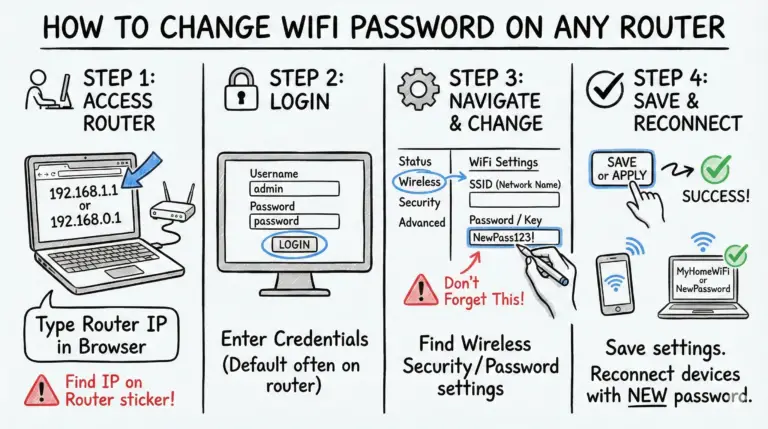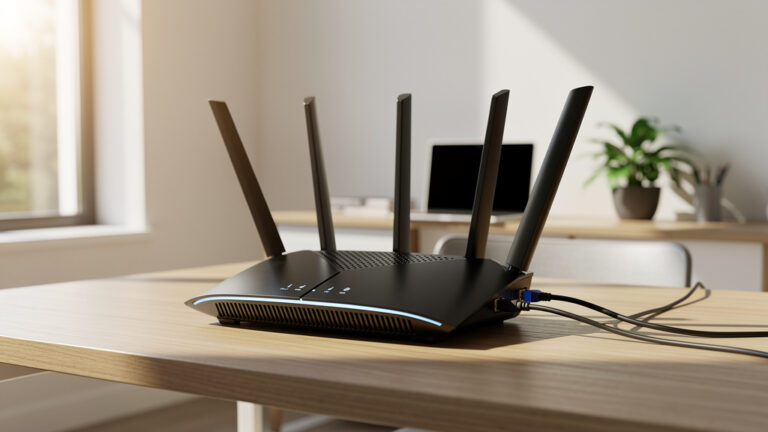The key difference between Dual Band vs. Tri-band WiFi routers is, you guessed it right, Dual-band has two bands (2.4GHz + 5GHz), and Tri-Band has three bands (2.4GHz + 5GHz + (5GHz or 6GHz)).
The extra band offered by Tri-Band routers doubles the bandwidth available for devices that use the 5GHz or 6Ghz frequency, offering improved performance for homes with many devices or intensive internet usage. This extra band can also help reduce congestion and enhance speeds for high-bandwidth activities like streaming, gaming, and downloading.
In this article, we will talk about the differences between dual-band and tri-band Wi-Fi routers, compare their specifications, and provide recommendations to assist you in determining the ideal router type for your needs.
Dual Band vs Tri-Band WiFi Routers Comparison Table
| Specs | Dual Band Router | Tri Band Router |
|---|---|---|
| Frequency Bands | 2.4GHz + 5GHz | 2.4GHz + 5GHz + (5GHz or 6GHz) |
| Maximum Speed | Up to 1750Mbps | Up to 7800Mbps |
| Standards | 802.11n, 802.11ax, 802.11b, 802.11ac, 802.11g | 802.11n, 802.11ax, 802.11a, 802.11g, 802.11ac |
| 5GHz Radios | 1 | 2 |
| 6Ghz Radio | 0 | 1 |
| 2.4GHz Performance | 300Mbps max | 300Mbps max |
| 5GHz Performance | 1300Mbps max per band | 2200Mbps max per band |
| 6Ghz Performance | N/A | 7800 Mbps |
| Device Support | Medium – Good | Excellent |
| Congestion Handling | Medium | Excellent |
| Range | – 2000-2500 sq.ft. (2.4GHz) – 1000-1500 sq.ft. (5GHz) | 2500-3500 sq.ft. |
| Ideal Home Size | Small to medium | Large homes |
| Ports | 4-8 ports | 4-10 ports |
| Price | $50 – $200 | $200 – $500+ |
| Use Cases | – Light usage – 5-15 devices – Basic streaming | – Heavy usage – 30+ devices – 4K, gaming, VR |
For my house, a good dual-band router with a wifi extender hits the sweet spot. Models like the TP-Link Archer A7 provide excellent performance and value without breaking the bank. I have fast speeds for web browsing and streaming with just a few devices connected.
What are dual-band WiFi Routers?
Dual band wireless routers have two radios – one for the 2.4GHz band and one for the 5GHz band. The 2.4GHz band is older and provides wider coverage but is prone to interference. The newer 5GHz band delivers faster speeds with less congestion, yet has a shorter range. An optimal router supports modern standards like 802.11ac WiFi 5 or 802.11ax WiFi 6 on 5GHz.
Dual-Band Routers – Pros and Cons
Ideal Usage Scenarios
- Smaller homes and apartments
- Budget-conscious shoppers
- Fewer connected devices
Popular Dual Band Router Models



What are tri-band WiFi Routers?
Tri band routers enhance dual band models by incorporating a second 5GHz radio band. This furnishes three discrete bands – the original 2.4GHz plus two separate 5GHz bands. However, there are also tri-band routers that support the 6 GHz band in addition to the 2.4 GHz and 5 GHz bands. These routers are known as WiFi 6E tri-band routers.
The extra 5GHz or 6 GHz band increases available bandwidth, reducing congestion when numerous devices connect at once. It also enables superior channel management to decrease interference.
Tri-Band Routers
Ideal Usage Scenarios
- Large homes with many connected devices
- Smart homes with 4K/8K TVs, cameras, etc.
- Gamers and media streamers
Popular Tri-Band Router Models



Key Differences Between Dual-Band and Tri-Band WiFi Routers
| Specs | Dual Band | Tri-Band |
|---|---|---|
| Frequency Bands | 2.4GHz + 5GHz | 2.4GHz + 5GHz + (5GHz or 6GHz) |
| Max Speed | Up to 1750Mbps | Up to 7800Mbps |
| Congestion Handling | Okay | Excellent |
| Price | $50 – $200 | $200 – $500 |
Which One Should You Choose? Dual Band or Tri-Band
For most homes, a capable dual-band router will satisfy the needs of an average household with 5-15 connected devices. Dual-band routers deliver a good balance of range, speed, and value.
However, if you have a larger home, 30+ devices, multiple 4K video streams, gaming, or an extensive smart home – a tri band router is likely the superior option. The extra 5GHz radio helps minimize congestion and interference for faster speeds. But be prepared to pay more.
Take inventory of your device count, home size, internet speeds, and simultaneous usage requirements. If your needs match tri band router strengths, the investment will be merited. Otherwise, a dual band router should fulfill average demands at a lower price.
Check out WiFi Mesh vs Extender vs Booster vs Repeater: Which Is Best For Your Home article if you are not getting the proper WiFi coverage in your home.
If you’re curious about the practical implications of internet speeds, the below posts will provide a comprehensive analysis.
- Is 10 Mbps fast Enough?
- The Ultimate Guide to 200 Mbps Internet Speed: Is 200 Mbps Fast Enough
- Is 500 Mbps Fast? Exploring Internet Speeds and Performance in 2023
- Is 600 Mbps Fast Internet Speed?
- Is 1000 Mbps Fast Internet? (The Gold Standard of Internet Speeds)
Additional Considerations When Selecting a Router
Beyond dual band vs tri band, also evaluate:
- Wireless standards – Get a router with WiFi 5 or WiFi 6 for maximum speeds
- Range – Check the router’s range in square feet for whole home coverage
- Number of antennas – More antennas provide wider coverage
- Ports – Ensure adequate Ethernet ports for wired connections
- Security – Select robust protocols like WPA3 encryption
- Firmware – Check for upgradeable firmware to get new features
The Future is WiFi6
Emerging WiFi6 routers will utilize cutting-edge optimizations like OFDMA plus 1024 QAM on both dual band and tri band models for faster speeds. Wi-Fi 6 certification indicates next-generation devices.
Dual band Wi-Fi 6 routers focus on squeezing more bandwidth from 5GHz while tri band Wi-Fi 6 routers add capacity with the third 5GHz radio. Both will outperform Wi-Fi 5.
Conclusion
Dual band routers offer an excellent balance of affordability and performance for typical households. Step up to a tri band router if you need to expand capacity to power a busy, smart home or keep multiple devices streaming smoothly.
I would suggest carefully assessing your specific usage, household size, and budget. Leverage expert advice and real-world user experiences. Look for modern standards like Wi-Fi 6 to future-proof your investment. Carefully weighing dual band vs tri band options will lead you to the right router.
Frequently Asked Questions (FAQs)
Is tri-band or dual band better?
Tri-band is generally better for homes with many connected devices, 4K/8K streaming, gaming, or large spaces. Dual-band is sufficient for lighter usage with fewer devices.
What is the advantage of a tri-band router?
The key advantage of a tri-band router is reduced congestion and interference by adding a third 5GHz band. This allows for faster speeds across more devices.
Does Triband make a difference?
For high-demand households, the extra 5GHz band on a tri-band router can make a significant difference in Wi-Fi performance and speed.
Is it better to have wi-fi 6 or tri-band?
Wi-Fi 6 tri-band routers provide the best performance by combining the speed and capacity enhancements of Wi-Fi 6 with the additional 5GHz band of tri-band. Wi-Fi 6 dual-band routers are also faster than Wi-Fi 5.
- How to Configure a Secure Site-to-Site VPN on Cisco Firepower Complete Guide - December 3, 2025
- Jobs for Network Engineers: Roles, Skills & Pay - December 3, 2025
- How to Change WiFi Password on Any Router : The Last Guide You Need - December 1, 2025



